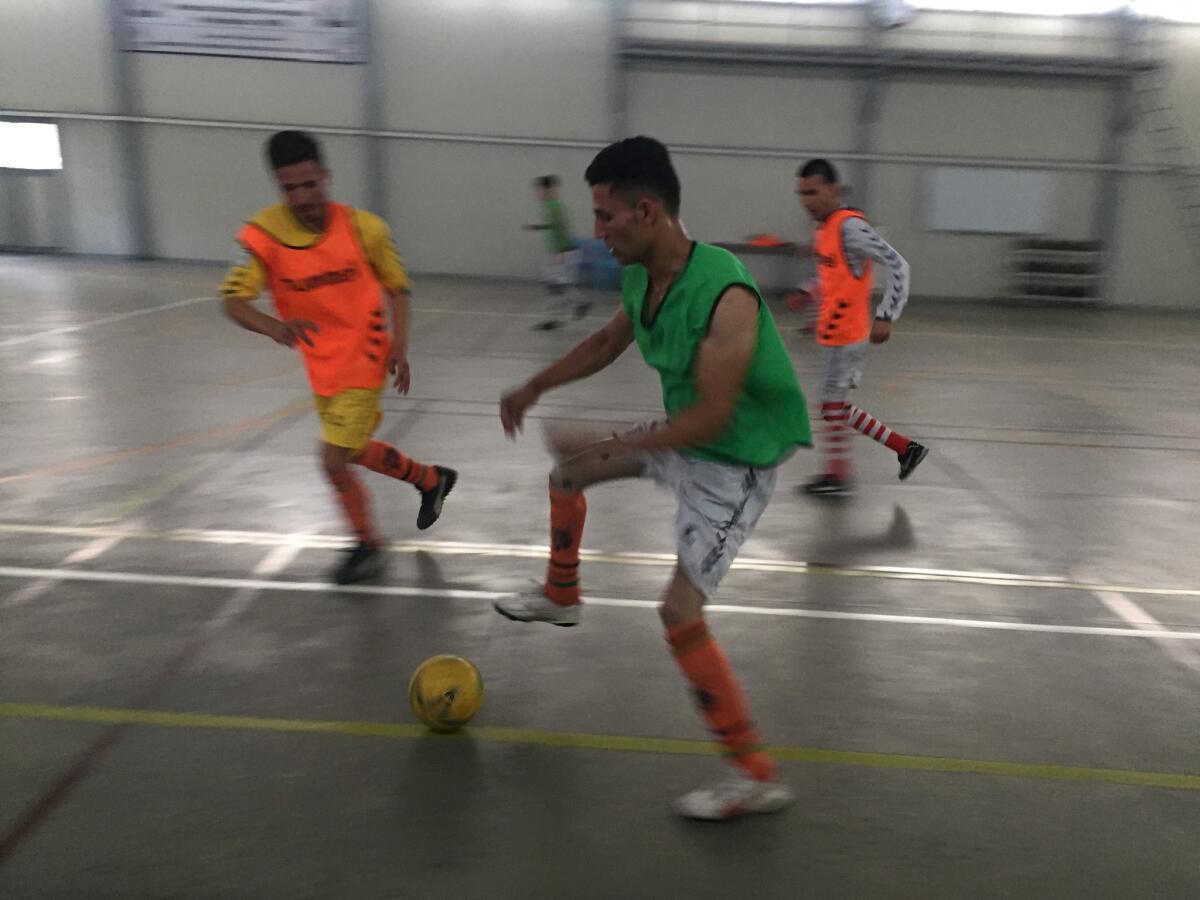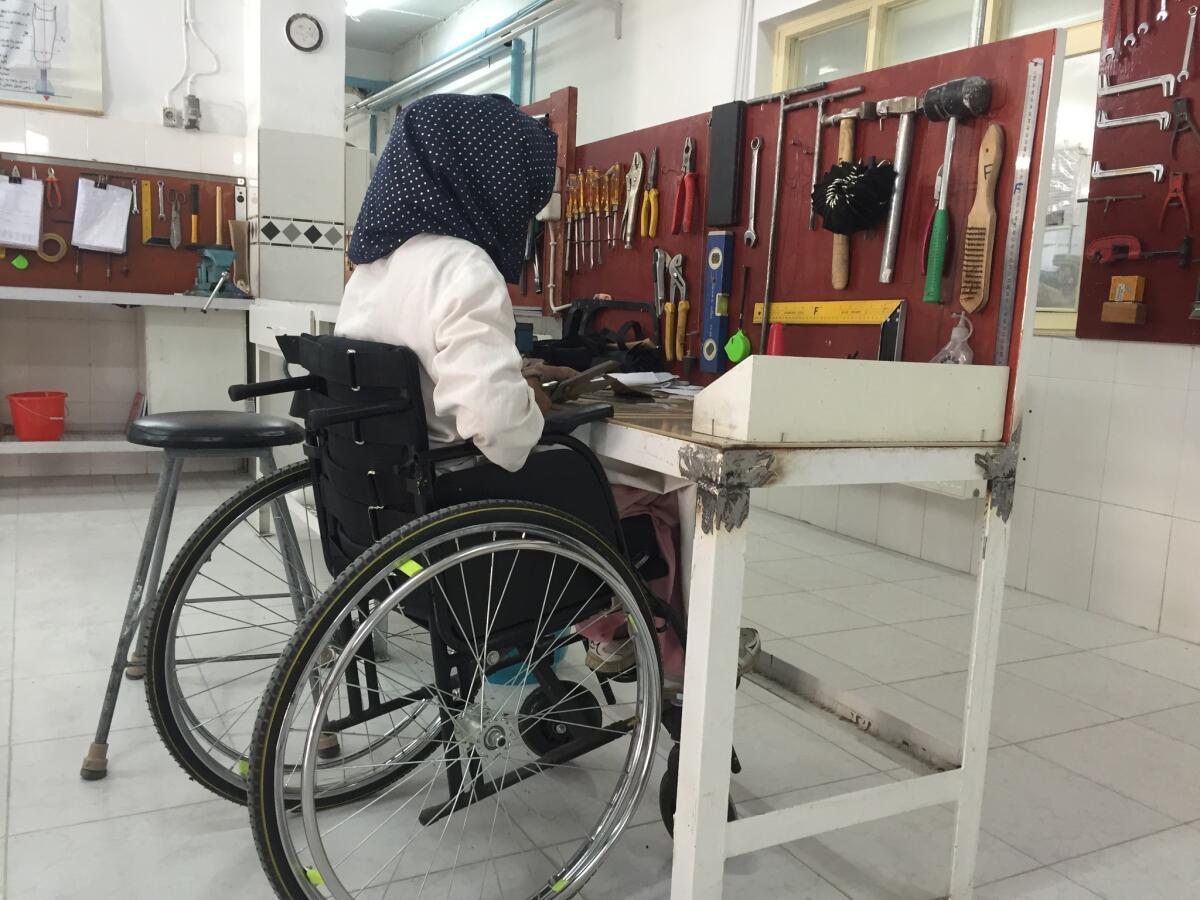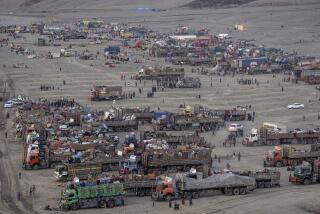At a Red Cross facility in Afghanistan, war victims battle trauma by helping others

Paralyzed from the waist down by a roadside bomb two years ago, 23-year-old Wajeeta is trying to help other Afghans who have suffered a similar fate.
Last month, the mother of three began a training program to learn how to mold artificial limbs under the supervision of the International Committee of the Red Cross in Kabul. Wajeeta had been under the care of her parents since her injury, but said she hoped to be hired full time in order to cope with her trauma and support her children.
“Two more candidates have been trying to get this job, but I want this job more than others,” said Wajeeta, who, like many Afghans, goes by one name.
Nearly all of the 700 Afghans employed by the organization at rehabilitation centers across the country are disabled. More than half manufacture artificial limbs or provide physical therapy and rehabilitation to people affected by more than three decades of conflict in Afghanistan.
All have been trained and are supervised by foreign staff, but the program puts disabled Afghans at the forefront of caring for others wounded by war.
The Kabul center is the largest of seven that the international Red Cross group operates in Afghanistan, where it has been providing free artificial limbs since 1988.
Wajeeta and her family were driving from Kabul, the capital, to the eastern province of Paktia when their car was struck by a roadside bomb that was believed to have been intended for a local tribal elder.
Wajeeta, who was more than eight months’ pregnant, suffered broken bones in her midsection. Forced to deliver her baby by cesarean section, she has entrusted the child, now almost 2, to her mother’s care.
“It’s painful that I couldn’t embrace my baby daughter,’’ she said.
Now, Wajeeta works eight hours a day at the Red Cross center and recently learned how to repair molds of artificial limbs. Her colleagues include men and women who suffer from a variety of disabilities.
A senior staff member at the center, Karima Hasanyar, was 5 when a rocket landed in her house in Kabul, maiming her knee and leaving her with a permanent limp. Now 22, she examines child patients in the cerebral palsy ward, fitting them with prosthetic limbs.
The majority of patients at the Kabul facility are disabled from birth, arriving from provinces surrounding the capital that lack decent hospitals.
Afghanistan is poorly equipped to accommodate those with disabilities. Buses, stairs, elevators, toilets and sidewalks in public places are not accessible to the physically handicapped. Wheelchairs are often makeshift contraptions, fashioned by local welders.
Those missing legs often have to be carried by another person.

In addition to molding artificial limbs, the Red Cross helps with exercise and rehabilitation. In 2013, the organization built a gym in Kabul where disabled adults and children play sports, including wheelchair basketball, volleyball, tennis and futsal, a form of indoor soccer. The daily training includes physical exercises, competitive matches and ball-control tactics.
Muharram Ali Mohammadi, 38, from Wardak province, says he developed futsal for the disabled in Afghanistan. Having lost his right hand during Afghanistan’s civil war in the 1990s, he now works as a futsal trainer at the international Red Cross gym.
“I’m here to prove that disability isn’t weakness, but a limitation,” he said.
Mohammadi said discrimination and a lack of awareness of people with disabilities prevent many from getting jobs. He has learned to type with his left hand but said government institutions rarely hire people like him.
Massoudullah Shahin, 25, from Takhar province in the north, suffered a hip injury in a suicide bombing eight years ago. Now in his fifth year of medical school at Kabul University, where he is studying to become an anesthesiologist, he said he doesn’t miss a game of futsal at the gym.
Being among other injury victims helps minimize his trauma, he said.
“I suffered a lot [of discrimination] for not being able to bend my leg in meetings, while using city transportation and even at big events,” he said.
He underwent years of treatment in his hometown, then in eastern Afghanistan, Kabul and later neighboring Pakistan. All those years, he used a cane. But since beginning therapy and exercise at the Red Cross center last year, he has tossed the cane and gets around with a mild limp.
Faizy is a special correspondent.
ALSO
Bombing at Afghanistan protest kills 81; Islamic State claims responsibility
How a stockpile of America’s nuclear weapons got tangled up in a Middle East crisis
Shooting in Munich fits a pattern that’s all too familiar — but not for Germany
More to Read
Sign up for Essential California
The most important California stories and recommendations in your inbox every morning.
You may occasionally receive promotional content from the Los Angeles Times.










